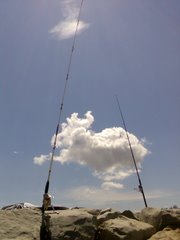Con't
2. More serious grouper anglers will opt for the second approach, called a live bait rig. This one had a sliding egg sinker on the line above the leader. The leader is long, sometimes five or six feet long. The hook of choice on this rig is a circle hook, normally about 8/0 or 9/0 in size (an 8/0 circle hook is about the same size as a 5/0 regular hook).
- Both of these bottom rigs use monofilament leaders. The choice of leader material for most anglers is fluorocarbon. Advertised as virtually invisible to fish, it does seem to draw more strikes that regular monofilament.
- The long leader allows a live bait to swim more freely and naturally than a short leader. The sliding egg sinker allows a fish to take the bait and swim off without feeling the weight of the sinker.
- All of the preparation so far is pretty standard fare for almost any bottom fish. The difference in and secret to grouper fishing comes in how you handle the strike.
- Grouper run out, grab a bait, and head back for cover. This habit will cause many lost fish and hung lines. Serious grouper anglers will crank the drag down on their reel as hard as they can, often using a pair of pliers to lock it down. The idea is to stop the grouper from taking line and returning to his structure home.
When a grouper strikes, anglers will lay their rod on the rail and start winding as hard as they can. The circle hook will handle hooking itself. The battle now is one of brute strength between angler and fish. More often than not the fish wins! - When a grouper makes it into a rock or reef, many anglers will simply break off the line and try again. The savvy angler will give the fish a loose line for as long as thirty minutes to allow the fish to relax and possibly swim out from under the structure. It has worked for many anglers on more than one occasion.
Nxt ---> TBA

No comments:
Post a Comment